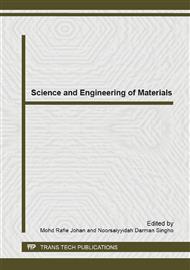[1]
S.M. Lee, T.K. Tsotsis, Indentation failure behavior of honeycomb sandwich panels, Compos. Sci. Technol. 60 (2000) 1147–1159.
DOI: 10.1016/s0266-3538(00)00023-3
Google Scholar
[2]
C.C. Foo, L.K. Seah, G.B. Chai, Low-velocity impact failure of aluminium honeycomb sandwich panels, Compos. Struct. 85 (2008) 20–28.
DOI: 10.1016/j.compstruct.2007.10.016
Google Scholar
[3]
V. Crupi, G. Epasto, E. Guglielmino, Collapse modes in aluminium honeycomb sandwich panels under bending and impact loading, Int. J. Impact Eng. 43 (2012) 6–15.
DOI: 10.1016/j.ijimpeng.2011.12.002
Google Scholar
[4]
F. Zhu, G. Lu, D. Ruan, Z. Wang, Plastic deformation, failure and energy absorption of sandwich structures with metallic cellular cores, Int. J. Protect. Struct. 1 (2010) 507–541.
DOI: 10.1260/2041-4196.1.4.507
Google Scholar
[5]
M. Nguyen, D. Elder, J. Bayandor, A review of explicit finite element software for composite impact analysis, J. Compos. Mater. 39 (2005) 375–86.
DOI: 10.1177/0021998305046739
Google Scholar
[6]
I.M. Daniel, E.E. Gdoutos, K.A. Wang, Failure of composite sandwich beams, Adv. Compos. Lett. 11 (2002) 101–109.
Google Scholar
[7]
S. Zhu, G.B. Chai, Effect of adhesive in sandwich panels subjected to low-velocity impact, Proc. Inst. Mech. Eng. L: J. Mater. Des. Appl. 225 (2011) 171–181.
Google Scholar
[8]
P. Navarro, S. Abrate, J. Aubry, S. Marguet, J.F. Ferrero, Analytical modeling of indentation of composite sandwich beam, Compos. Struct. 100 (2013) 79–88.
DOI: 10.1016/j.compstruct.2012.12.017
Google Scholar
[9]
B. Hachemane, R. Zitoune, B. Bezzazi, C. Bouvet, Sandwich composites impact and indentation behaviour study, Compos. B: Eng. 51 (2013) 1–10.
DOI: 10.1016/j.compositesb.2013.02.014
Google Scholar
[10]
A. Abbadi, Y. Koutsawa, A. Carmasol, S. Belouettar, Z. Azari, Experimental and numerical characterization of honeycomb sandwich composite panels, Simul. Model. Pract. Th. 17 (2009) 1533–1547.
DOI: 10.1016/j.simpat.2009.05.008
Google Scholar


